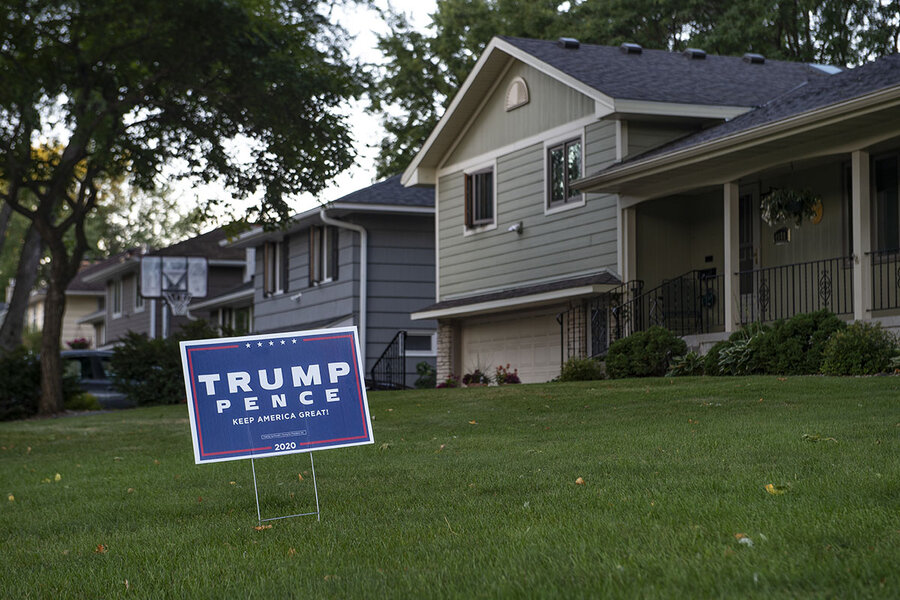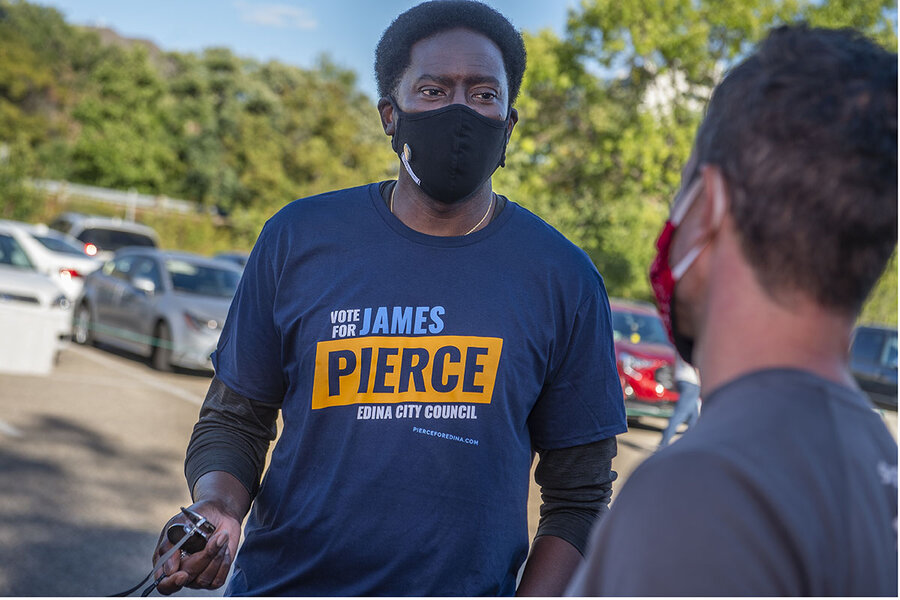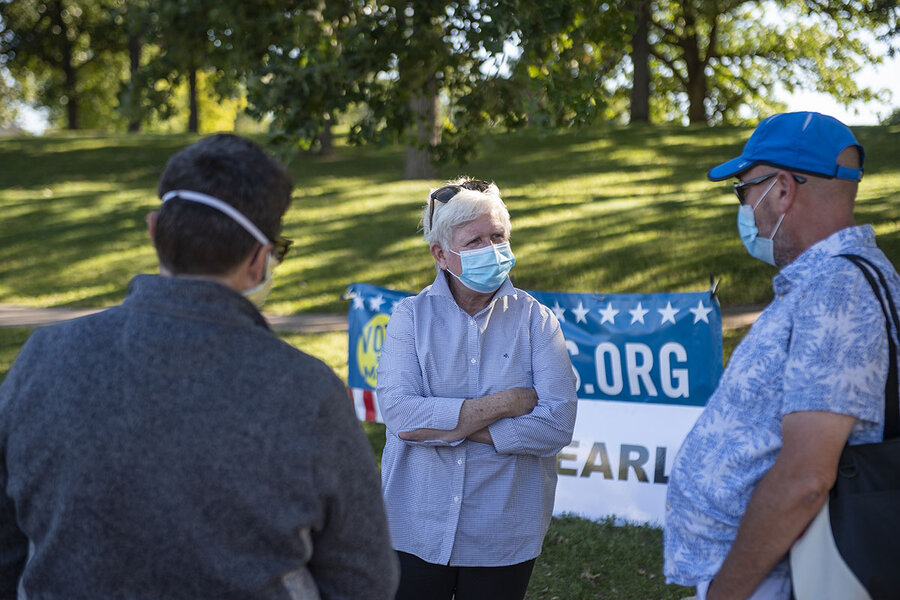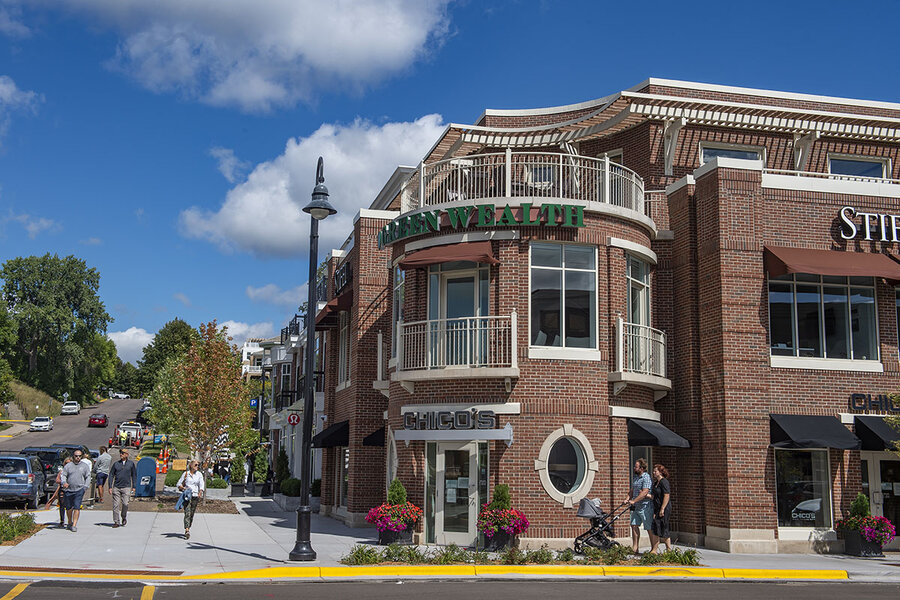In Midwest, Trump’s ‘law and order’ message wins some, loses others
Loading...
| Wayzata, Minnesota
President Donald Trump is continuing to push “law and order” as a main presidential campaign theme – a message that emerged amid the din of Mr. Trump’s controversial performance in a presidential debate Tuesday. One of his electoral targets is the upper Midwest, particularly Wisconsin and Minnesota. But he continues to trail in these critical swing states.
The president narrowly won Wisconsin four years ago, and barely lost Minnesota. Both states have had peaceful Black Lives Matter protests followed by some urban violence – in Minnesota following the death of George Floyd under a Minneapolis police officer’s knee, and in Wisconsin after the shooting of Jacob Blake in Kenosha.
Why We Wrote This
President Trump is trying to win back white suburban voters in Wisconsin and Minnesota – but so far his focus on urban unrest isn’t helping him in the polls. One reason: the suburbs are changing.
The Trump campaign believed the “law and order” theme, which includes the president’s rhetoric claiming the election of Joe Biden would lead to burning cities, could help him in the vote-rich Republican suburbs around Minneapolis and Milwaukee. Indeed, it is easy to find voters in these areas who say they’re even more convinced to vote for Mr. Trump.
But so far, the president doesn’t seem to be attracting more than his core voters with this approach.
“He’s not driving up his vote margin much, if at all, because he’s not shifting the views of independents whose votes might change,” says Charles Franklin, director of the Marquette Law School Poll in Milwaukee.
If President Donald Trump’s portrayal of himself as the avatar of “law and order” is going to help him at the 2020 ballot box anywhere, it might be here in the key swing states of the Upper Midwest.
The target for the president’s tough message is white suburban and rural voters worried by protests that have, on occasion, led to arson and looting. And in 2020, Minnesota and neighboring Wisconsin have been at the epicenter of the social justice uproar over police violence against Black Americans, after the death of George Floyd under an officer’s knee in Minneapolis, and the shooting of Jacob Blake in Kenosha.
Indeed, in Wayzata, a leafy town 16 miles from where Mr. Floyd was killed, it’s not hard to find residents who say the unrest has increased their support for President Trump. His uncritical support for police and diatribes about “violent left-wing extremists” appears to be solidifying and energizing his base.
Why We Wrote This
President Trump is trying to win back white suburban voters in Wisconsin and Minnesota – but so far his focus on urban unrest isn’t helping him in the polls. One reason: the suburbs are changing.
Yet overall, polls indicate that the “law and order” tactic, reminiscent of the way Richard Nixon ran for the presidency in 1968, isn’t boosting Mr. Trump much in these northern states – or at least, not enough to win.
In Minnesota – a state his campaign is trying hard to flip red in 2020 – he trails Democratic nominee Joe Biden by 8.8 percentage points, according to a FiveThirtyEight average of major polls. And while the president leads with rural voters in the state, Minnesota suburban residents prefer Mr. Biden by a whopping 20 percentage points, according to a New York Times/Siena College poll.
In Wisconsin, which Mr. Trump won narrowly in 2016, he trails Mr. Biden by 6.7 points, according to FiveThirtyEight. Charles Franklin, a government scholar and director of the Marquette Law School Poll in Milwaukee, says that the president’s visit to Kenosha in the wake of the destruction there improved his standing in the eyes of Republicans. But in a sense he was preaching only to the choir.
“He’s not driving up his vote margin much, if at all, because he’s not shifting the views of independents whose votes might change,” says Dr. Franklin.
The “Blue Wall”
President Trump has made clear in recent days that he will not abandon his “law and order” rhetoric regardless of its apparent inability to move the needle in key states to this point. His Twitter feed continues to feature all-caps bursts of the phrase “LAW AND ORDER!” on a regular basis. At a recent rally in Moon Township, Pennsylvania, a wealthy and mostly white suburb of Pittsburgh, Mr. Trump invoked the “violent left-wing extremists” he claimed are supporting Mr. Biden.
“They will rip your cities apart,” he said. “They will go to the suburbs next.”
At the chaotic first presidential debate on September 29, Mr. Trump charged that if Mr. Biden “ever got to run this country ... our suburbs would be gone.” (“He wouldn’t know a suburb unless [he] took a wrong turn,” Mr. Biden retorted. “I was raised in the suburbs.”)
Four years ago, most pundits considered it a no-brainer that Minnesota and Wisconsin would go blue. Both have long histories of voting Democratic on the national level.
So many were shocked when Mr. Trump made both states competitive, winning Wisconsin (and neighboring Michigan) while coming within metaphorical inches of winning Minnesota as well.
In 2016, the GOP built an impressive ground game in Wisconsin prior to the election, doubling their outreach to voters and tripling their number of field offices. Meanwhile, Democratic nominee Hillary Clinton thought the Badger State was such a sure thing that she never visited over the course of her campaign. She lost to Trump by 0.7 percent.
Mrs. Clinton won Minnesota, long the bluest Upper Midwest state, by 1.5 percentage points – the smallest Democratic margin in decades. Four years earlier, former President Barack Obama won by almost 8 percentage points.
Mr. Trump has long considered Minnesota the one that got away in 2016, and in 2020 it may be one of his few potential pickup states. To this point, the Trump campaign plans to spend more on ads in Minnesota than Wisconsin or Michigan.
To be sure, Mr. Trump stormed through the “Blue Wall” of the Midwest because of his unprecedented turnout in rural corners of these states. Still, the 2020 outcome here may ultimately hinge on the suburbs.
For proof, look no farther than the 2018 midterms. In Wisconsin, incumbent Republican Gov. Scott Walker lost reelection largely because he underperformed in the suburbs, with a big decline in his vote margin in the traditionally GOP “WOW” counties. In Minnesota, Democrats flipped two previously Republican congressional seats in the Minneapolis suburbs – victories that helped them regain a majority in the U.S. House.
The president’s “law and order” message is likely a thinly-veiled attempt to stop this suburban vote erosion before November. And in the Milwaukee and Twin Cities suburbs it may be working to some extent. Local Republicans say it is particularly appealing to white women, a voter group that was soft for the party in the 2018 midterms.
“Sure, there are some women who are on the fence, but that is getting slimmer and slimmer because of Kenosha,” says Nancy Kormanik, president of the Republican Women of Waukesha County in Wisconsin. “This is all happening too close for comfort. Too close.”
Ms. Kormanik says her membership has tripled over the past three years, now totaling around 145. And 10 of those new members were spurred to join after the events in nearby Kenosha, she says.
But suburbs are changing all over America. They are becoming more racially and economically diverse, changing their political outlooks. That’s happening even here, in the prosperous suburbs of the states at the top of the Mississippi River.
James Pierce for City Council
From a distance, the very tall Black man stands out in the largely white crowd at the farmer’s market in Edina, Minnesota, a suburb of Minneapolis that is 88% white, according to the 2010 census. He is wearing a navy shirt that says, “James Pierce for City Council.”
It is Mr. Pierce himself, accompanied by his wife and daughters, who are also wearing similar “James Pierce” shirts. They have come to the market to campaign while perusing ripe tomatoes and flower bouquets. Mr. Pierce is an executive at the global food corporation Cargill, and hopes to win an Edina City Council seat on November 3.
“Our City Council has been all white for forever, I don’t know how many years. So we need a different perspective. We need multiple perspectives,” he says. “Given everything that’s been going on politically, I wanted to have a bigger impact in society.”
To illustrate how, he tells a story about political lawn signs.
Supporters had been putting his signs up at night so they’d have an impact when people woke up and saw them. They had about 20 left, so Mr. Pierce decided one evening to take them out and deliver them himself. The sun had set, and his wife Stephanie looked at him and said, “Well no, you can’t do that.”
“So, I did a post to thank my supporters and say that I had this conversation with my wife saying I shouldn’t go out, and I talked about why,” he says.
Mr. Pierce grew up in Montgomery, Alabama. In the Deep South, racism was so overt that he just had lower expectations for the people who lived there, he says. In the Midwest, when he encounters similar attitudes, it affects him more.
“Because here, I have a higher expectation of people,” he says.
In certain communities, people think racism is a thing of the past, that they’ve come far and evolved, Mr. Pierce says.
“One of the things I do to try to shake people out of that thinking is, I say, ‘You know, I’m 51 and I’m the first person in my family who was born with the right to vote,’” he says.
But there’s another thing that’s different about the Midwest, he adds. People are willing to do something about it – to try to make a change to beat racism back.
His wife Stephanie is at the heart of a virtual book club consisting of herself and 19 white women, and that’s all they talk about. It was formed when friends reached out to her following the death of George Floyd.
“They are reading books, finding articles, and then getting on these calls every three weeks and saying, ‘What can we do differently?’” Mr. Pierce says.
Across the parking lot at the farmers market, Colleen Miner, president of the group Edina Indivisible, sits in a lawn chair in front of a “How to Vote” sign.
Ms. Miner has always voted herself, but that was the limit of her political activism. No more, she says – the turmoil of American politics since the election of President Trump has woken her up.
“I think of Minneapolis as a well-run, fair and just city – and after George Floyd, we find out it has a huge amount of racism. I was stunned because I’m in Edina, I’m in this bubble,” says Ms. Miner, periodically interrupting herself to ask passersby if they have questions on how to vote by mail.
“I feel ashamed that I didn’t know about it before, but I know it now,” she says. “And I’ve got to do something about it.”
Midwest racism
Over the past several years, with the rise of the ubiquitous cell phone camera, filmed incidents of lethal police force against Black Americans – often by white officers – have surfaced across the country, often invoking outrage, sometimes inciting violence.
Many of the most viral incidents occurred in the Midwest.
In 2014, for example, Michael Brown, a teenager, and Tamir Rice, a child, were both shot by white police officers in Ferguson, Missouri, and Cleveland, Ohio, respectively. In 2016 Philando Castile was killed by a Hispanic police officer while inside his car in a suburb outside St. Paul, Minnesota. And this year saw the death of Minneapolis’ George Floyd and shooting of Kenosha’s Jacob Blake.
While cases of racial injustice happen across the country, “it’s not surprising” that the Midwest is a hotbed, says Christy Clark-Pujara, a historian at the University of Wisconsin-Madison.
When she travels to the U.S. coasts, Ms. Clark-Pujara, a Black woman who has lived in the Midwest her entire life, says people are surprised to hear where she’s from. And when she’s on campus in Madison, locals are surprised to hear she’s a professor.
“A lot of times the media uses the term ‘Midwest’ to mean ‘white,’” says Ms. Clark-Pujara, adding that her own field of Midwest racial history has really only developed over the past 15 years.
“So when we envision, as a nation, the Midwest as this white space, something like Kenosha feels surprising,” she says.
Perhaps it shouldn’t. Last year, Milwaukee was rated #1 in the country for racial disparities by 24/7 Wall Street, a Delaware-based financial news and opinion company, with nearby Racine, Wisconsin, coming in second and Minneapolis coming in fourth. Nine of the top 10 cities on the 24/7 list are located in the Midwest.
“The silent majority”
In the suburbs surrounding Minneapolis and Milwaukee, a number of white voters said they approve of President Trump and his “law and order” rhetoric. If anything, some said, recent events had only solidified their intention to vote for him in the 2020 election.
Strolling along downtown Wayzata, Minnesota, past a boutique aromatherapy shop and salons selling $48 shampoo, Doreen, a tanned mom in white Bermuda shorts sipping on a large iced Starbucks drink, says she made herself vote for Mr. Trump in 2016 because she didn’t like Mrs. Clinton. But now, she says she’s excited to vote for the president in November. She believes he knows how to get the economy back on track, and unlike the Minneapolis mayor and Minnesota governor, he will put a stop to protest-related violence.
“They even had to board up here in Wayzata for the [George Floyd] protests, and that was really sad,” says Doreen, who declines to give her last name. “I think the whole state will go red in Minnesota for the first time in forever,” she adds.
Further down the block, Nanci is walking toward her car with her husband and mother, carrying a bag of leftover food from their seafood lunch on the water. She says they spent lunch talking about the presidential race – all agreeing that violent protests in nearby cities this summer made them more determined to vote for Mr. Trump. Although they live just 20 minutes outside of Minneapolis, she says they don’t go into the city anymore due to the recent destruction.
“All of this violence in these Democratic cities – the Democrats don’t do anything about it,” she says. “Trump is for law and order, and so are we.”
Outside the post office in Elm Grove, Wisconsin, a small town that proudly proclaims itself “Rated #1 suburb by Business Insider in 2014,” Mickey, an administrative assistant with short blond hair, says the recent unrest in Kenosha has only confirmed her suspicion that Democrats – up and down the ballot – are too soft on crime.
“It seems like the cities with Democratic leaders, they’re just letting this run rampant,” says Mickey. “Whether that reflects on Biden personally, I don’t know – but it sure reflects on the party.”
As for the polls showing Mr. Biden with durable leads in both Wisconsin and Minnesota, Ms. Kormanik, of the Republican Women of Waukesha County, says they are likely inaccurate because of “shy Trump” voters who won’t tell pollsters who they really favor.
“The majority of women in Waukesha County are not confrontational. They will show their support at the polls and they will bring their families to the polls, but they will not come out and say who they really support,” says Ms. Kormanik. “The women here are the silent majority.”
Staff writer Christa Case Bryant contributed to this report.












